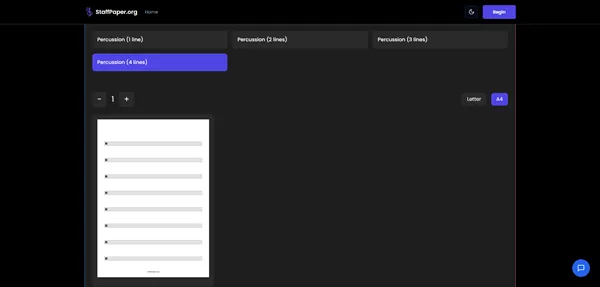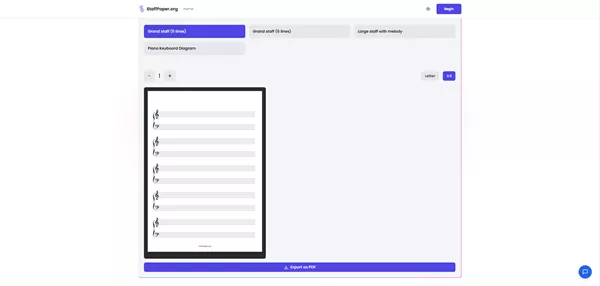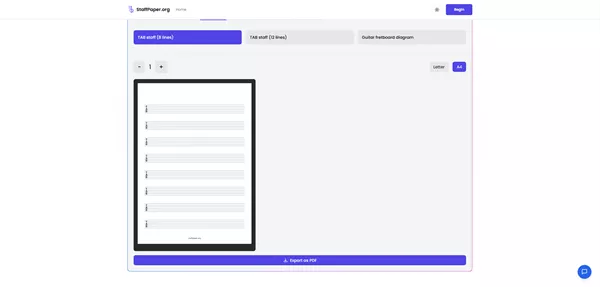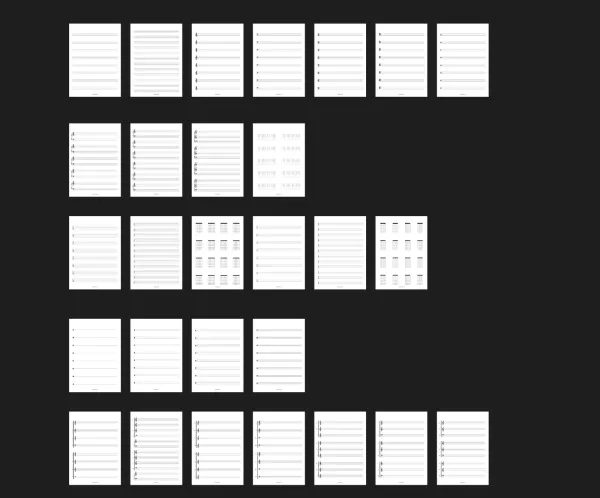अपना संगीत मुक्त करें: संगीतकारों के लिए स्टाफ पेपर गाइड
क्या आप एक नवोदित संगीतकार, एक अनुभवी संगीतज्ञ, या एक भावुक संगीत शिक्षक हैं जो अपने छात्रों को प्रेरित करने के लिए उत्सुक हैं? यदि ऐसा है, तो आपने निस्संदेह स्टाफ पेपर का सामना किया होगा। लेकिन संगीत स्टाफ पर क्यों लिखा जाता है, और स्टाफ पेपर को क्या कहा जाता है? यह गाइड संगीत में स्टाफ पेपर की आवश्यक भूमिका का पता लगाता है और, सबसे महत्वपूर्ण बात, यह बताता है कि इसे मुफ्त में कहाँ से प्राप्त करें! अपने संगीत के सपनों को साकार करने के लिए तैयार हैं? अपनी सभी आवश्यकताओं के लिए स्टाफ पेपर के विशाल चयन की खोज करें – अभी रचना शुरू करें!

स्टाफ पेपर को समझना: संगीत संकेतन की नींव
स्टाफ पेपर, जिसे संगीत स्टाफ पेपर के रूप में भी जाना जाता है, लिखित संगीत का आधार बनाता है। यह संगीत विचारों को पकड़ने और साझा करने के लिए संरचना प्रदान करता है। इसके बिना, जटिल सामंजस्य, जटिल राग और लयबद्ध पैटर्न को सटीकता के साथ संप्रेषित करना चुनौतीपूर्ण होगा।
स्टाफ पेपर को क्या कहा जाता है? सामान्य नामों की खोज
आप स्टाफ पेपर को विभिन्न नामों से जान सकते हैं: संगीत पांडुलिपि पत्र, शीट संगीत पत्र, या बस संगीत पत्र। लेबल के बावजूद, इसका उद्देश्य समान रहता है: संगीत संकेतन के लिए एक मानकीकृत ग्रिड प्रदान करना।
स्टाफ पेपर पर कितनी रेखाएँ होती हैं? मानक समझाया गया
मानक स्टाफ पेपर में पाँच क्षैतिज रेखाएँ और चार रिक्तियाँ होती हैं। ये रेखाएँ और रिक्तियाँ विभिन्न संगीत पिचों का प्रतिनिधित्व करती हैं; रेखा या रिक्ति जितनी ऊँची होगी, पिच उतनी ही ऊँची होगी। इन पंक्तियों पर संगीत को पढ़ने और लिखने में महारत संगीत साक्षरता के लिए महत्वपूर्ण है।

स्टाफ पेपर के प्रकार: अपनी आवश्यकताओं के लिए सही का चयन करना
सभी स्टाफ पेपर समान नहीं बनाए जाते हैं! विभिन्न संगीत अनुप्रयोगों के लिए विभिन्न प्रकार के संगीत स्टाफ पेपर की आवश्यकता होती है।
मानक स्टाफ पेपर: सामान्य रचना के लिए आदर्श
यह सामान्य संगीत लेखन के लिए आपकी पसंद है। चाहे आप कोई राग बना रहे हों, कोई गीत बना रहे हों, या कोई सिम्फनी लिख रहे हों, मानक स्टाफ पेपर एकदम सही खाली स्लेट प्रदान करता है।
पियानो स्टाफ पेपर: कीबोर्ड उपकरणों के लिए ग्रैंड स्टाफ
पियानो संगीत ग्रैंड स्टाफ का उपयोग करता है, जिसमें दो पाँच-रेखाएँ स्टेव होते हैं जो एक ब्रेस से जुड़े होते हैं। ऊपरी स्टाफ आमतौर पर तीव्र क्लेफ़ (दाएँ हाथ के लिए) प्रदर्शित करता है, जबकि निचला स्टाफ बास क्लेफ़ (बाएँ हाथ के लिए) दिखाता है। अपनी कीबोर्ड रचनाओं के लिए पियानो स्टाफ पेपर के हमारे रेंज का अन्वेषण करें।

गिटार टैब बनाम स्टाफ पेपर: एक तुलना
जबकि गिटार टैबलेट (टैब) गिटारवादकों के बीच लोकप्रिय है, स्टाफ पेपर को पढ़ना सीखने से संगीत की व्यापक संभावनाओं का पता चलता है। स्टाफ संकेतन आपको अंतर्निहित संगीत संरचना को समझने और विभिन्न वाद्ययंत्र बजाने वाले संगीतकारों के साथ प्रभावी ढंग से संवाद करने की अनुमति देता है।

ऑनलाइन मुफ़्त स्टाफ पेपर कहाँ खोजें: डाउनलोड करने योग्य संसाधन
अच्छी खबर यह है कि स्टाफ पेपर तक पहुँचने के लिए आपको अपने बजट पर जोर देने की ज़रूरत नहीं है! हमारी साइट संगीतकारों को मुफ़्त स्टाफ पेपर संसाधन प्रदान करने के लिए समर्पित है।
स्टाफ पेपर पीडीएफ: सुविधाजनक और प्रिंट करने योग्य विकल्प
हम आसान डाउनलोड और प्रिंटिंग के लिए स्टाफ पेपर पीडीएफ फ़ाइलों का एक विविध संग्रह प्रदान करते हैं। यह उन लोगों के लिए आदर्श है जो संगीत रचना के लिए पारंपरिक पेन-एंड-पेपर दृष्टिकोण पसंद करते हैं।
प्रिंट करने योग्य स्टाफ पेपर: उच्च-गुणवत्ता वाली शीट्स को प्रिंट करने के सुझाव
इष्टतम परिणामों के लिए, एक लेजर प्रिंटर और उच्च-गुणवत्ता वाले पेपर का उपयोग करें। गहरी, स्पष्ट रेखाएँ सुनिश्चित करने के लिए प्रिंटर सेटिंग्स को समायोजित करें। अपनी परियोजनाओं के लिए अभी सही प्रिंट करने योग्य स्टाफ पेपर प्राप्त करें!
स्टाफ पेपर का उपयोग कैसे करें: संगीत लेखन के लिए शुरुआती गाइड
स्टाफ पेपर का उपयोग करना सीखना एक नई भाषा सीखने के समान है - इसके लिए समय और प्रयास की आवश्यकता होती है, लेकिन पुरस्कार पर्याप्त हैं।
संगीत प्रतीकों को समझना: नोट्स, क्लेफ़ और समय हस्ताक्षर
शुरू करने से पहले, बुनियादी संगीत प्रतीकों से परिचित हों: नोट्स, क्लेफ़ (तीव्र, बास, आल्टो, टेनर), और समय हस्ताक्षर। ये प्रतीक पिच, लय और समग्र संगीत संरचना में महत्वपूर्ण अंतर्दृष्टि प्रदान करते हैं।
साफ और सुपाठ्य संगीत संकेतन के लिए सुझाव
स्पष्टता आवश्यक है! एक तेज पेंसिल या पेन का उपयोग करें, और सावधानीपूर्वक लिखें। सुसंगत अंतर और स्पष्ट संकेतन पठनीयता और प्रदर्शन को बढ़ाएंगे।
विभिन्न वाद्ययंत्रों के लिए स्टाफ पेपर: चार्ट की हमारी रेंज का अन्वेषण करें
जबकि हम पूरी तरह से अनुकूलित स्टाफ पेपर की पेशकश नहीं करते हैं, हम विभिन्न वाद्ययंत्रों के लिए तैयार चार्ट की एक विस्तृत श्रृंखला प्रदान करते हैं। मानक स्टेव से लेकर विशेष लेआउट जैसे TAB स्टाफ (8 लाइनें), TAB स्टाफ (12 लाइनें), और गिटार फ्रेटबोर्ड आरेख तक, आपको अपनी रचना प्रक्रिया को सुव्यवस्थित करने के लिए सही संगीत स्टाफ पेपर मिलेगा।

पियानो के लिए स्टाफ पेपर: ग्रैंड स्टाफ समझाया गया
जैसा कि पहले बताया गया है, पियानो संगीत ग्रैंड स्टाफ का उपयोग करता है। पियानोवादकों और कीबोर्ड खिलाड़ियों के लिए ग्रैंड स्टाफ को समझना महत्वपूर्ण है।
गिटार के लिए स्टाफ पेपर: स्टाफ संकेतन और टैब का संयोजन
कई गिटारवादियों को स्टाफ संकेतन को गिटार टैब के साथ संयोजित करना उपयोगी लगता है, जो आपको विशिष्ट फ्रेट/स्ट्रिंग और अंतर्निहित संगीत पिच दोनों को देखने की अनुमति देता है।
आपकी संगीत यात्रा सही स्टाफ पेपर से शुरू होती है
स्टाफ पेपर किसी भी संगीतकार, शुरुआती या समर्थक के लिए अपरिहार्य है। संगीत संकेतन के लिए एक मानकीकृत ढांचा प्रदान करके, यह आपको अपने संगीत के सपनों को पकड़ने, साझा करने और साकार करने की अनुमति देता है। इसलिए, स्टाफ पेपर की शक्ति को अपनाएँ और अपनी संगीत क्षमता को मुक्त करें! आज अपना मुफ़्त स्टाफ पेपर डाउनलोड करें और बनाना शुरू करें!
FAQ: स्टाफ पेपर के बारे में अक्सर पूछे जाने वाले प्रश्न
शीट संगीत के लिए सबसे अच्छा पेपर क्या है?
शीट संगीत के लिए आदर्श पेपर चमकीला सफेद, एसिड-मुक्त, एक चिकनी सतह के साथ होता है। यह उत्कृष्ट कंट्रास्ट प्रदान करता है और स्याही के रिसाव को रोकता है।
संगीत में स्टाफ लेखक क्या होता है?
संगीत के संदर्भ में, एक "स्टाफ लेखक" सबसे अधिक संभावना एक संगीतकार या गीतकार को संदर्भित करता है जो संगीत बनाने के लिए स्टाफ पेपर का उपयोग करता है। वे स्टाफ पेपर पर संगीत संकेतन का उपयोग करके एकल या कई वाद्ययंत्रों के लिए रचनाएँ लिखते हैं, यह निर्देश देते हैं कि प्रत्येक वाद्ययंत्र को टुकड़ा कैसे बजाना चाहिए। खुद स्टाफ लेखक बनने के लिए हमारे संसाधनों का अन्वेषण करें!
संगीत स्टाफ पर क्यों लिखा जाता है?
संगीत को स्टाफ पर पिच और लय का एक मानकीकृत प्रतिनिधित्व प्रदान करने के लिए लिखा जाता है। रेखाएँ और रिक्तियाँ नोट्स के अनुरूप होती हैं, जिससे सटीक व्याख्या और प्रदर्शन की अनुमति मिलती है। अपना स्टाफ पेपर पीडीएफ प्राप्त करें और अक्षरों के नामों के साथ संगीत स्टाफ के बारे में जानें।